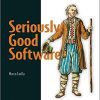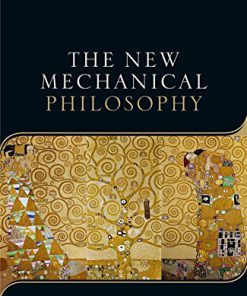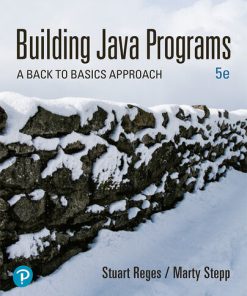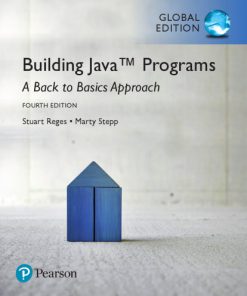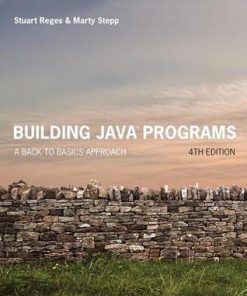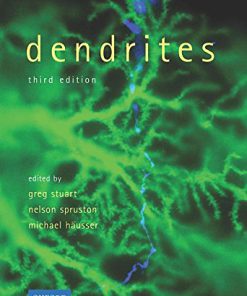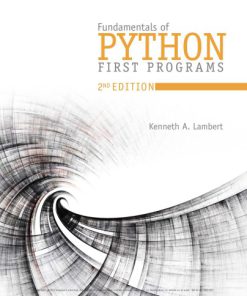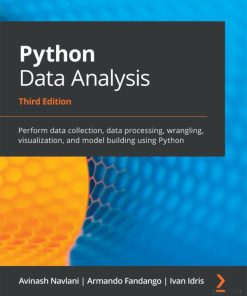Building Python Programs 1st Edition by Stuart Reges, Allison Obourn, Marty Stepp 9780135201046 0135201047
$50.00 Original price was: $50.00.$25.00Current price is: $25.00.
Building Python Programs 1st Edition by Stuart Reges, Allison Obourn, Marty Stepp – Ebook PDF Instant Download/Delivery: 9780135201046, 0135201047
Full download Building Python Programs 1st Edition after payment
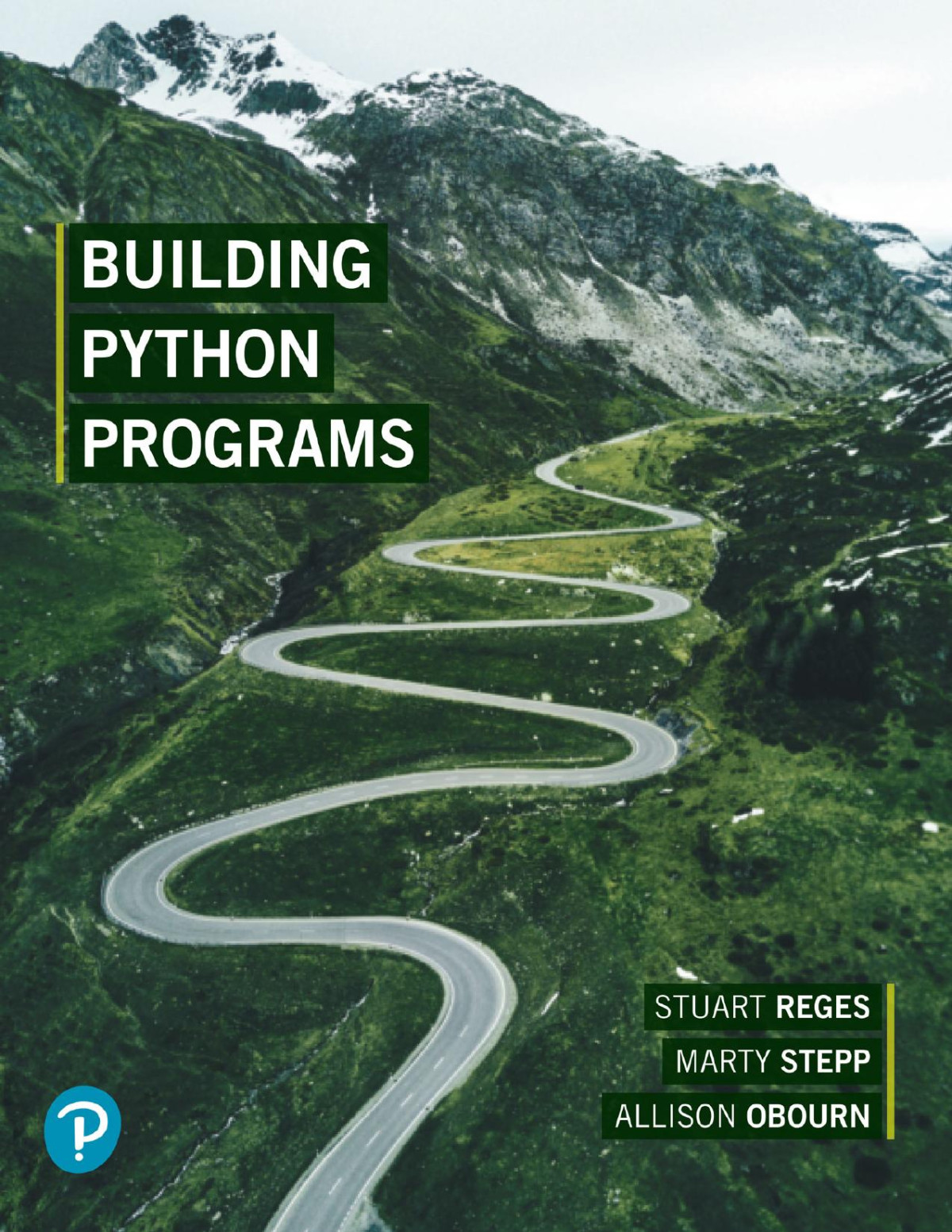
Product details:
• ISBN 10:0135201047
• ISBN 13:9780135201046
• Author:Stuart Reges, Allison Obourn, Marty Stepp
Building Python Programs
For courses in Java programming. A layered, back-to-basics approach to Python programming The authors of the long successful title, Building Java Programs, bring their proven and class-tested, back-to-basics strategy to teaching Python programming for the first time in Building Python Programs. Their signature layered approach introduces programming fundamentals first, with new syntax and concepts added over multiple chapters. Object-oriented programming is discussed only after students have developed a basic understanding of Python programming. This newly published textfocuses on problem solving with an emphasis on algorithmic thinking and is appropriate for the two-semester sequence in introductory computer science. Also available with MyLab Programming By combining trusted author content with digital tools and a flexible platform, MyLab personalizes the learning experience and improves results for each student.With MyLab Programming, students work through hundreds of short, auto-graded coding exercises and receive immediate and helpful feedback based on their work. Note: You are purchasing a standalone product; MyLab Programming does not come packaged with this content. Students, if interested in purchasing this title with MyLab Programming, ask your instructor for the correct package ISBN and Course ID. Instructors, contact your Pearson representative for more information. If you would like to purchase both the physical text and MyLab Programming, search for: 0135287057/9780135287057 Building Python Programs Plus MyLab Programming with Pearson eText — Access Card Package Package consists of: 0135201276 / 9780135201275 MyLab Programming with Pearson eText — Access Card — for Building Python Programs 0135205980 / 9780135205983 Building Python Programs
Building Python Programs 1st Table of contents:
Chapter 1 Introduction to Python Programming
Introduction
1.1 Basic Computing Concepts
Why Programming?
Hardware and Software
The Digital Realm
The Process of Programming
Why Python?
The Python Programming Environment
1.2 And Now: Python
Printing Output
String Literals (Strings)
Escape Sequences
Printing a Complex Figure
Comments, Whitespace, and Readability
1.3 Program Errors
Syntax Errors
Logic Errors (Bugs)
1.4 Procedural Decomposition
Functions
Flow of Control
Identifiers and Keywords
Functions That Call Other Functions
An Example Runtime Error
1.5 Case Study: Drawing Figures
Structured Version
Final Version without Redundancy
Analysis of Flow of Execution
Chapter Summary
Self-Check Problems
Section 1.1: Basic Computing Concepts
Section 1.2: And Now: Python
Section 1.3: Program Errors
Section 1.4: Procedural Decomposition
Exercises
Programming Projects
Chapter 2 Data and Definite Loops
Introduction
2.1 Basic Data Concepts
Types
Expressions
Literals
Arithmetic Operators
Precedence
Mixing and Converting Types
2.2 Variables
A Program with Variables
Increment/Decrement Operators
Printing Multiple Values
2.3 The for Loop
Using a Loop Variable
Details about Ranges
String Multiplication and Printing Partial Lines
Nested for Loops
2.4 Managing Complexity
Scope
Pseudocode
Constants
2.5 Case Study: Hourglass Figure
Problem Decomposition and Pseudocode
Initial Structured Version
Adding a Constant
Chapter Summary
Self-Check Problems
Section 2.1: Basic Data Concepts
Section 2.2: Variables
Section 2.3: The for Loop
Section 2.4: Managing Complexity
Exercises
Programming Projects
Chapter 3 Parameters and Graphics
Introduction
3.1 Parameters
The Mechanics of Parameters
Limitations of Parameters
Multiple Parameters
Parameters versus Constants
Optional Parameters
3.2 Returning Values
The math Module
The random Module
Defining Functions That Return Values
Returning Multiple Values
3.3 Interactive Programs
Sample Interactive Program
3.4 Graphics
Introduction to DrawingPanel
Drawing Lines and Shapes
Colors
Drawing with Loops
Text and Fonts
Images
Procedural Decomposition with Graphics
3.5 Case Study: Projectile Trajectory
Unstructured Solution
Structured Solution
Graphical Version
Chapter Summary
Self-Check Problems
Section 3.1: Parameters
Section 3.2: Returning Values
Section 3.3: Interactive Programs
Section 3.4: Graphics
Exercises
Programming Projects
Chapter 4 Conditional Execution
Introduction
4.1 if/else Statements
Relational Operators
Nested if/else Statements
Factoring if/else Statements
Testing Multiple Conditions
4.2 Cumulative Algorithms
Cumulative Sum
Min/Max Loops
Cumulative Sum with if
Roundoff Errors
4.3 Functions with Conditional Execution
Preconditions and Postconditions
Raising Exceptions
Revisiting Return Values
Reasoning about Paths
4.4 Strings
String Methods
Accessing Characters by Index
Converting between Letters and Numbers
Cumulative Text Algorithms
4.5 Case Study: Basal Metabolic Rate
One-Person Unstructured Solution
Two-Person Unstructured Solution
Two-Person Structured Solution
Procedural Design Heuristics
Chapter Summary
Self-Check Problems
Section 4.1: if/else Statements
Section 4.2: Cumulative Algorithms
Section 4.3: Functions with Conditional Execution
Section 4.4: Strings
Exercises
Programming Projects
Chapter 5 Program Logic and Indefinite Loops
Introduction
5.1 The while Loop
A Loop to Find the Smallest Divisor
Loop Priming
5.2 Fencepost Algorithms
Fencepost with if
Sentinel Loops
Sentinel with Min/Max
5.3 Boolean Logic
Logical Operators
Boolean Variables and Flags
Predicate Functions
Boolean Zen
Short-Circuited Evaluation
5.4 Robust Programs
The try/except Statement
Handling User Errors
5.5 Assertions and Program Logic
Reasoning about Assertions
A Detailed Assertions Example
5.6 Case Study: Number Guessing Game
Initial Version without Hinting
Randomized Version with Hinting
Final Robust Version
Chapter Summary
Self-Check Problems
Section 5.1: The while Loop
Section 5.2: Fencepost Algorithms
Section 5.3: Boolean Logic
Section 5.4: Robust Programs
Section 5.5: Assertions and Program Logic
Exercises
Programming Projects
Chapter 6 File Processing
Introduction
6.1 File-Reading Basics
Data and Files
Reading a File in Python
Line-Based File Processing
Structure of Files and Consuming Input
Prompting for a File
6.2 Token-Based Processing
Numeric Input
Handling Invalid Input
Mixing Lines and Tokens
Handling Varying Numbers of Tokens
Complex Input Files
6.3 Advanced File Processing
Multi-Line Input Records
File Output
Reading Data from the Web
6.4 Case Study: ZIP Code Lookup
Chapter Summary
Self-Check Problems
Section 6.1: File-Reading Basics
Section 6.2: Token-Based Processing
Section 6.3: Advanced File Processing
Exercises
Programming Projects
Chapter 7 Lists
Introduction
7.1 List Basics
Creating Lists
Accessing List Elements
Traversing a List
A Complete List Program
Random Access
List Methods
7.2 List-Traversal Algorithms
Lists as Parameters
Searching a List
Replacing and Removing Values
Reversing a List
Shifting Values in a List
Nested Loop Algorithms
List Comprehensions
7.3 Reference Semantics
Values and References
Modifying a List Parameter
The Value None
Mutability
Tuples
7.4 Multidimensional Lists
Rectangular Lists
Jagged Lists
Lists of Pixels
7.5 Case Study: Benford’s Law
Tallying Values
Completing the Program
Chapter Summary
Self-Check Problems
Section 7.1: List Basics
Section 7.2: List-Traversal Algorithms
Section 7.3: Reference Semantics
Section 7.4: Multidimensional Lists
Exercises
Programming Projects
Chapter 8 Dictionaries and Sets
Introduction
8.1 Dictionary Basics
Creating a Dictionary
Dictionary Operations
Looping Over a Dictionary
Dictionary Ordering
8.2 Advanced Dictionary Usage
Dictionary for Tallying
Nested Collections
Dictionary Comprehensions
8.3 Sets
Set Basics
Set Operations
Set Efficiency
Set Example: Lottery
Chapter Summary
Self-Check Problems
Section 8.1: Dictionary Basics
Section 8.2: Advanced Dictionary Usage
Section 8.3: Sets
Exercises
Programming Projects
Chapter 9 Recursion
Introduction
9.1 Thinking Recursively
A Nonprogramming Example
Iteration to Recursion
Structure of Recursive Solutions
Reversing a File
The Recursive Call Stack
9.2 Recursive Functions and Data
Integer Exponentiation
Greatest Common Divisor
Directory Crawler
9.3 Recursive Graphics
Cantor Set
Sierpinski Triangle
9.4 Recursive Backtracking
Traveling North/East
Eight Queens Puzzle
Stopping after One Solution
9.5 Case Study: Prefix Evaluator
Infix, Prefix, and Postfix Notation
Evaluating Prefix Expressions
Complete Program
Chapter Summary
Self-Check Problems
Section 9.1: Thinking Recursively
Section 9.2: Recursive Functions and Data
Section 9.3: Recursive Graphics
Section 9.4: Recursive Backtracking
Exercises
Programming Projects
Chapter 10 Searching and Sorting
Introduction
10.1 Searching and Sorting Libraries
Binary Search
Sorting
Shuffling
10.2 Program Complexity
Empirical Analysis
Complexity Classes
10.3 Implementing Searching and Sorting Algorithms
Sequential Search
Binary Search
Recursive Binary Search
Selection Sort
10.4 Case Study: Implementing Merge Sort
Splitting and Merging lists
Recursive Merge Sort
Runtime Performance
Hybrid Approach
Chapter Summary
Self-Check Problems
Section 10.1: Searching and Sorting in the Python Class Libraries
Section 10.2: Program Complexity
Section 10.3: Implementing Searching and Sorting Algorithms
Section 10.4: Implementing Merge Sort
Exercises
Programming Projects
Chapter 11 Classes and Objects
Introduction
11.1 Object-Oriented Programming
Classes and Objects
Date Objects
11.2 Object State and Behavior
Data Attributes
Initializers
Methods
Accessors and Mutators
Making Objects Printable
Object Equality and Ordering
11.3 Encapsulation
Motivation for Encapsulation
Private Attributes and Properties
Class Invariants
11.4 Case Study: Designing a Stock Class
Object-Oriented Design Heuristics
Stock Attributes and Method Headers
Stock Method and Property Implementation
Chapter Summary
Self-Check Problems
Section 11.1: Object-Oriented Programming
Section 11.2: Object State and Behavior
Section 11.3: Encapsulation
Section 11.4: Case Study: Designing a Stock Class
Exercises
Programming Projects
Chapter 12 Functional Programming
Introduction
12.1 Functional Programming Concepts
Side Effects
First-Class Functions
Higher-Order Functions
Lambda Expressions
12.2 Functional Operations on Collections
Using Map
Using Filter
Using Reduce
List Comprehensions
12.3 Function Closures
Generator Functions
Lazy Evaluation
Iterable Objects
Generator Expressions
12.4 Case Study: Perfect Numbers
Computing Sums
The Fifth Perfect Number
Leveraging Concurrency
Chapter Summary
Self-Check Problems
Section 12.1: Functional Programming Concepts
Section 12.2: Functional Operations on Collections
Section 12.3: Function Closures
Exercises
Programming Projects
Appendix A: Python Summary
Keywords and Operators
Keywords
Commonly Used Data Types
Arithmetic Operators
Relational Operators
Logical Operators
Operator Precedence
Syntax Templates
Control Statements:
Input and Output:
Functions:
Libraries:
Collections:
Classes:
Useful Functions/Methods
Built-In Global Functions
Dictionary (dict) operations
DrawingPanel Methods and Properties
Exception Types
Methods of File Objects
Functions of os.path Library
List Operations
Global Functions That Operate on Lists/Sequences
Math Constants
Functions in the math Module
Functions of random Module
Set (set) Operations
String Methods
People also search for Building Python Programs 1st:
building python programs 1st edition
building python programs 1st edition pdf
building python programs 1st edition pdf free download
first python programs
building python programs pdf
You may also like…
Politics & Philosophy - Anthropology
Computers - Programming
Building Java Programs: A Back to Basics Approach, 5th Edition Stuart Reges
Politics & Philosophy
Building Community and Family Resilience: Research, Policy, and Programs Mike Stout
Computers - Programming
Building Java Programs – A Back to Basics Approach Stuart Reges
Computers - Programming
Medicine
Computers - Programming
Fundamentals of Python First Programs 2nd Edition by Kenneth Lambert 8214344317 9798214344317
Computers - Programming



